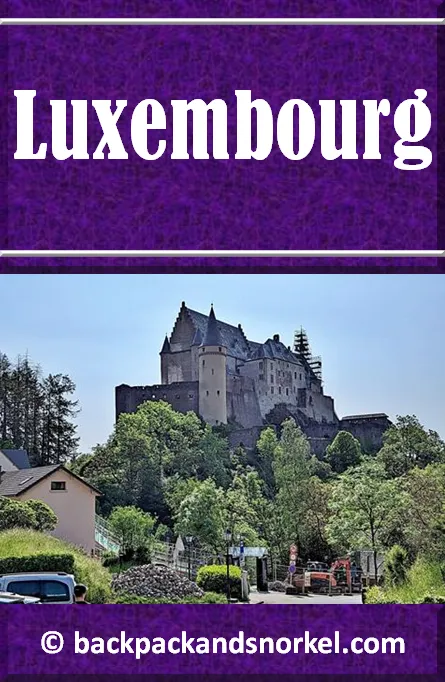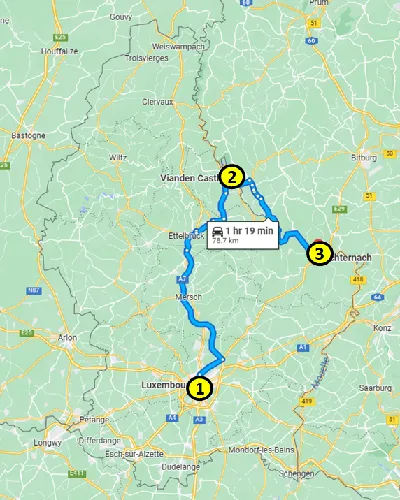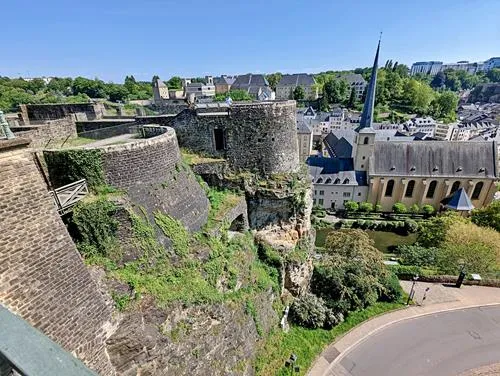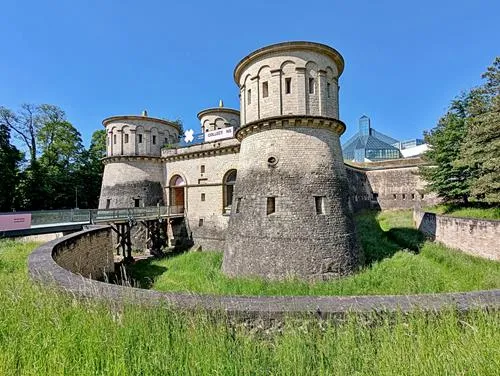Travel Guide for Vianden Castle and Echternach in Luxembourg - Luxembourg Purple Travel Guide
Vianden Castle and the town of Echternach are the top tourist attractions outside of Luxembourg City in Luxembourg, We provide detailed information and a self-guided walking tour with the best things to see and we show lots of photos so you know what you can expect.
Today is the last day of your 3-day Highlights of Luxembourg tour and a perfect day to explore highlights outside of Luxembourg City. To be exact, you will visit the Vianden Castle, Luxembourg’s most visited historical monument outside of Luxembourg City, and the town of Echternach, both near the border to Germany.
Even though there are ways to get to both locations by free public transportation, we recommend using your rental car as it is significantly faster, and you are more flexible.
The drive to Vianden Castle, your first destination, should take 45-50 min.
Vianden Castle
Vianden Castle sits on a rocky promontory at a height of 1,020 ft (310 m), dominating the town of Vianden and overlooking the River Our. It is one of the largest fortified castles west of the Rhine river and Luxembourg’s most visited historical monument outside of Luxembourg City.
At the time of writing, the opening hours were from 10am – 6pm (5pm in March and October and 4pm from November through February). Admission for adults is 10 € and discounts are available for students and children. We found it helpful to pay for audio guides (available in 10 languages), for an extra 2 € per audio guide, as there are only a few English descriptions; everything is in German and French.
At the entrance, you get a brochure with an outline of your self-guided tour. The rooms are numbered and that makes it real easy to follow the designated walking path.
There are a couple of small parking lots with paid parking close to the short trail that leads to the entrance. We paid for 2h and were back after about 1h 40min.
The first structure that was built on this site in 275 AD was a small fortification that acted as a shelter for townspeople in case of an attack. The structure was abandoned at around 430.
Around the year 1000, the stone castle was built here. It had a watch tower and was surrounded by an oval defensive wall.
At around 1100, a residential castle with a chapel, kitchen, and residential rooms was built and likely housed an aristocratic family.
At approx. 1170, a new and larger residential tower larger and a prestigious decagonal chapel were added, and the palace was extended. Over the years, multiple additions and modifications were made by the counts of Vianden. In the 13th century, the entire castle was changed to reflect Gothic style. Many of these modifications and extensions appear to have been made to rival the House of Luxembourg.
In 1417, the last descendant of the House of Vianden died and the castle was then used as storage and some of the outer structures were torn down. During the 16th century, the castle was mostly abandoned.
In 1820, King William I sold the castle to Wenzel Coster for 3,200 florins, who started to demolish the building and sell off everything, including the doors, windows, wooden paneling, roof beams, gutters and even roof tiles, leaving the castle in ruins.
The insult of the deconstruction of the once-proud castle angered the population, so the king purchased the ruin in 1827 for 1,100 florins with the goal of restoring it. Due to the Belgian Revolution of 1830, nothing happened until 1851, when Prince Henry of the Netherlands reconstructed the chapel at his own expense. More restorations were done until World War I interrupted the work.
In 1944, at the Battle of Vianden, the castle proved its military value when the Luxembourg Resistance was able to defend the castle against a much larger force of the Nazis.
After World War II, it took until 1962 that the Armory was reconstructed.
Work then halted until after Grand Duke Jean had ceded the castle to the country of Luxembourg in 1977. The castle’s exterior was restored to what you see today from 1978 – 1982. The interior restoration finished in1990.




By now, it is likely close to lunch time. You can either drive into Vianden for lunch or you can have a snack in the castle’s café and continue on to Echternach, which is your next destination, and eat lunch there.
The drive to Echternach should take 30-35 min.
Self-guided walking tour of Echternach in Luxembourg
Echternach is the oldest town in Luxembourg and one of the country’s highlights.
Where Echternach lies today, there was a 1st-century Roman villa which is said to have been the largest north of the Alps. This estate was passed to the see of Trier in the 6th century, which built a small monastery on the site.
In 698 Bishop Willibrord, an Anglo-Saxon missionary who was later elevated to Saint Willibrord, established the Abbey of Echternach on the site of a small monastery from the 6th century that was donated to him to build a larger monastery. Soon after, the town of Echternach started growing around the abbey and towards the nearby Sauer river.
In 1236, Echternach was granted a city charter.
During World War II, Echternach was badly damaged, but rebuilt and restored afterwards.
This self-guided walking tour of the town of Echternach requires about 1 mile (1.6 km) walking. It starts at the Abbey of Echternach. There is some limited parking (all paid parking) directly next to the abbey.
After your walking tour in town, you will need to drive to the parking lot south of town next to Villa Romaine and Lake Echternach. When you get there, it is only a short walk to Villa Romaine and Lake Echternach, and you can walk as little or as much as you like.

Abbey of Echternach / St. Willibrord Basilica Echternach
The Abbey of Echternach is a Benedictine monastery in the town of Echternach, near the German border.
In 698 Bishop Willibrord, an Anglo-Saxon missionary who was later elevated to Saint Willibrord, was appointed abbot, and tasked with establishing a larger monastery on the site of a small monastery from the 6th century.
Willibrord opened the Abbey of Echternach in 700 and secured the backing of many Irish monks, who would be part of the first settlement at Echternach.
After Willibrord’s death in 739 at age 81, the abbey soon became too small for the large number of pilgrims who came to visit his grave.
In the early ninth century, a larger, Carolingian-style church was constructed, but it burned down about 200 years later.
Charlemagne (King Charles the Great) was a strong supporter of the abbey, but when the Frankish state collapsed under his successor during the civil wars in the 830s the power of the abbey faded and in 847, the Benedictine monks were ejected.
In the 9th century before the Benedictine monks were ejected, Echternach Abbey was one the most important monastic manuscript writing sites in the Frankish empire – it produced the Augsberg gospel, the Maaseyck gospel, the Trier gospel, and the Freiburg gospel.
In 971, King Otto the Great restored the Benedictines to Echternach and the abbey entered a second Golden Age, as it became one of northern Europe's most influential abbeys once again.
In 1031, a new Romanesque church was consecrated. It was of a similar size to the basilica that we see today.
During the 13th century, gothic ornamentations were added to the interior and in the 17th century, various chapels were added.
In 1794, French troops plundered and desecrated the church and in 1797 it auctioned off and used as a pottery factory and for the first half of the 19th century as a military drill yard.
By 1850 the church was in ruins.
In 1862, an association was founded for the reconstruction of the church and the reconstruction in neo-roman style was completed in 1868, and the abbey was re-consecrated.
On the eve of World War II in 1939, Pope Pius XII granted the abbey the status of minor basilica in recognition of its importance as a national center of pilgrimage to St. Willibrord.
In 1944, parts of the basilica were destroyed and reconstruction after the war was done in the original Roman style to give the building that we see today. The building was re-consecrated in 1953.
When you visit the basilica, look at the stained-glass windows – they portray the life of Saint Willibrord and in the choir window, he is standing between the apostles Peter and Paul under an image of the Holy Trinity. The upper windows show people who played important parts in Willibrord’s life.
The rose window above the organ is decorated with the signs of the zodiac.
Below the basilica is the crypt with Willibrord’s tomb, which is made from Carrara marble. Eleventh century frescos adorn the ceiling, showing scenes from the life of the Virgin Mary.
Admission is free and the abbey is usually open from 8am – 6pm, Sundays from 1pm - 6pm.



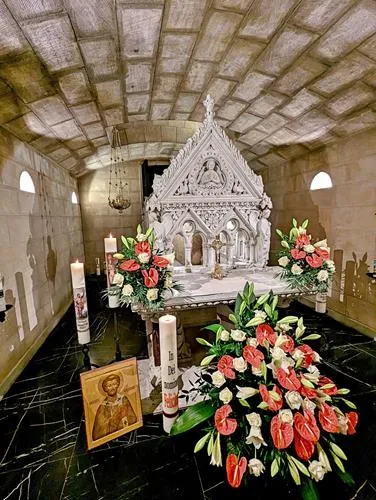
Orangerie / Abbey Garden
The Orangerie garden was built in 1736, during the reconstruction of the abbey. It has cross-shaped paths, a central water basin, statues of the four seasons and, originally, almost 400 fruit trees.

City Hall / former Palace of Justice (Denzelt)
justice (Denzelt). It is believed that it was built around 1236, but the exact year is not known.
The building was purchased in 1374 by Abbot Wilhelm von Kerpen.
It was heavily damaged by fire in 1444 and was rebuilt.
In 1520, it was rebuilt in Renaissance style, and, after another fire, Baroque elements were added in 1705.
More changes were made to the facade from 1895 - 1896 in neo-Gothic style and statues which represent the four cardinal virtues of prudence, bravery, moderation and justice, Virgin Mary, King Solomon, and Abbot Robert of Monreal were attached to the façade.
The building was partially destroyed during World War II, and rebuilt.
The building also housed a prison and torture chamber at the time when it was used as palace of justice. Today, the municipal council holds its meetings here and the registry office, city archives and an exhibition room are located in the building.
The building is not open to the public.
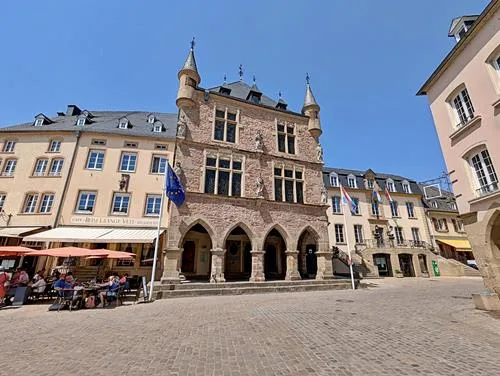

Croix de Justice / Column of Justice (Urtsel)
The Column of Justice is located in Market Square close to the former Palace of Justice (Denzelt). It was likely erected in 1236, when Countess Ermesinde of Luxembourg gave the city of Echternach her letter of freedom. After the construction of the former Palace of Justice (Denzelt), the column was used to proclaim the judgments from here. This gave it the nickname Urtsel (Judgment column).
In the late 18th century, the monument had become a symbol of the increasingly contested power of Echternach Abbey and in 1774, the citizens of Echternach wanted to replace it with statues of Justitia and Pax and with a fountain. Nothing happened until 1794, when French revolutionary troops occupied Echternach. It is unclear if locals or French troops or both tore it down.
At the place of the cross, a freedom tree was erected ‘amid song and music’. In 1798, a new freedom tree was planted.
In 1897, the architect who had restored the Palace of Justice (Denzelt) proposed to rebuild the old Column of Justice again, since the original drawings still existed. This proposal was very controversial and, again, nothing happened.
In 1920, the remains of the judicial cross were discovered in a garden in Echternach and in May 1929, the Echternach Beautification Association asked the municipal council to rebuild the Urtsel in its old form. It took until 1938 that the municipal council agreed to reconstruct the judicial cross on a different place in Market Square. Reconstruction work was finished in 1939.
The monument survived the battles of World War II with only a few scratches, but was removed in 1945 for US troop movements. It was re-erected in 1955 near the Abbey.
In 1979, the Echternach municipal council approved plans to move a replica of the judicial cross to its original location on Market Square. This was done in 1982 and in 1983, the Luxembourg Post issued a stamp with the Echternach judicial cross on it.


Echternach City Wall
Only a few parts of the city wall with its 20 towers and 4 gates survive until today. Most were badly damaged in World War II, but restored after the war. You can either walk to the remaining parts of the wall or drive there on your way to the next destination, Villa Romaine.
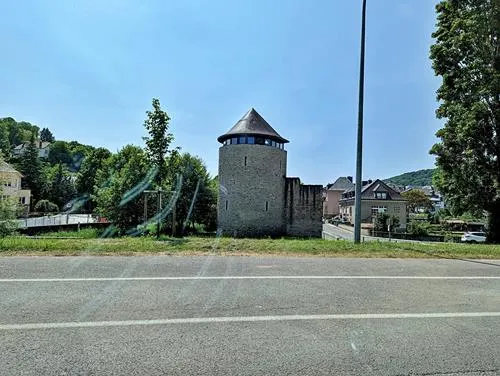
Villa Romaine
Villa Romaine lies on Lake Echternach and you can visit both attractions together.
To get there, drive to the Lake Echternach parking lot and then walk to Villa Romaine. Do not use the driving directions to Villa Romaine that google maps suggests from the parking lot, otherwise you will end up at a fence and locked gate.
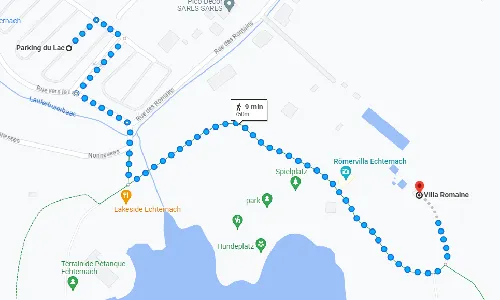
The tiny visitor center, which has good views on the ruins from the roof platform, is open from mid-April through the end of September from Tuesday – Sunday 10am – noon and 1p - 5pm. They offer periodic guided tours for which you have to pay – ask at the visitor center when those take place.
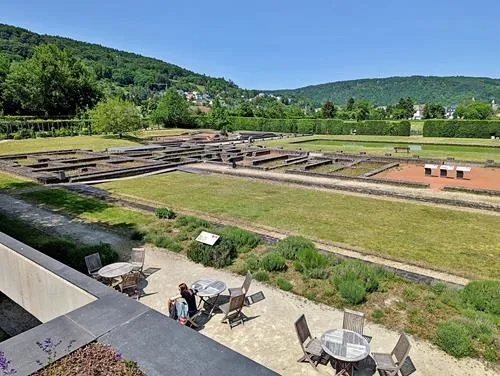

Lake Echternach
The area around Echternach is called Müllerthal. It is sometimes called ‘Little Switzerland of Luxembourg’, because of its beautiful scenery and numerous hiking trails.
No trip to Echternach is complete without a visit to Lake Echternach. The 74 acre (20 hectares) artificial lake is popular with locals, especially in summer, and tourists alike. There you can hike, bike, play beach volleyball, sunbathe, BBQ, swim in a small, designated swimming area (from May through September), kayak, pedal boat, or fish (with a permit). There are also several playgrounds for kids and some restaurants. Right next to the lake is a hostel in case you want to spend one or more nights near the lake.
There is one easy wheelchair accessible 2.1-mile (3.4 km) trail that goes around the lake and several unpaved hiking trails that lead you through Müllerthal.
To get to Lake Echternach, park at the Lake Echternach parking lot near the lake and then walk a few feet to the lake.


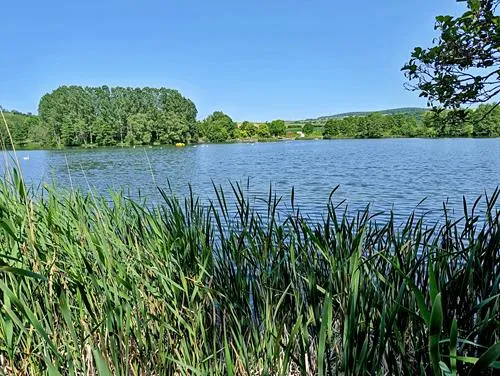
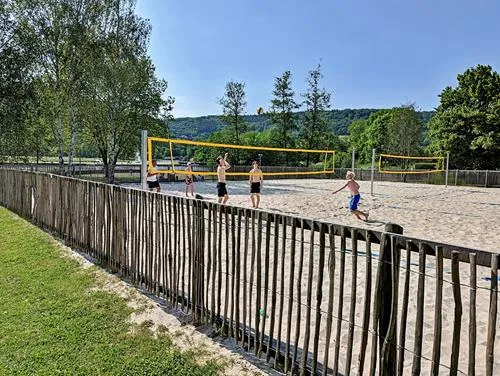
This concludes day 3 of your Luxembourg tour.
Where do you want to go now?
Author: Rudy at Backpack and Snorkel
Bio: Owner of Backpack and Snorkel Travel Guides. We create in-depth guides to help you plan unforgettable vacations around the world.
Other popular Purple Travel Guides you may be interested in:
Like this Backpack and Snorkel Purple Travel Guide? Pin these for later:




